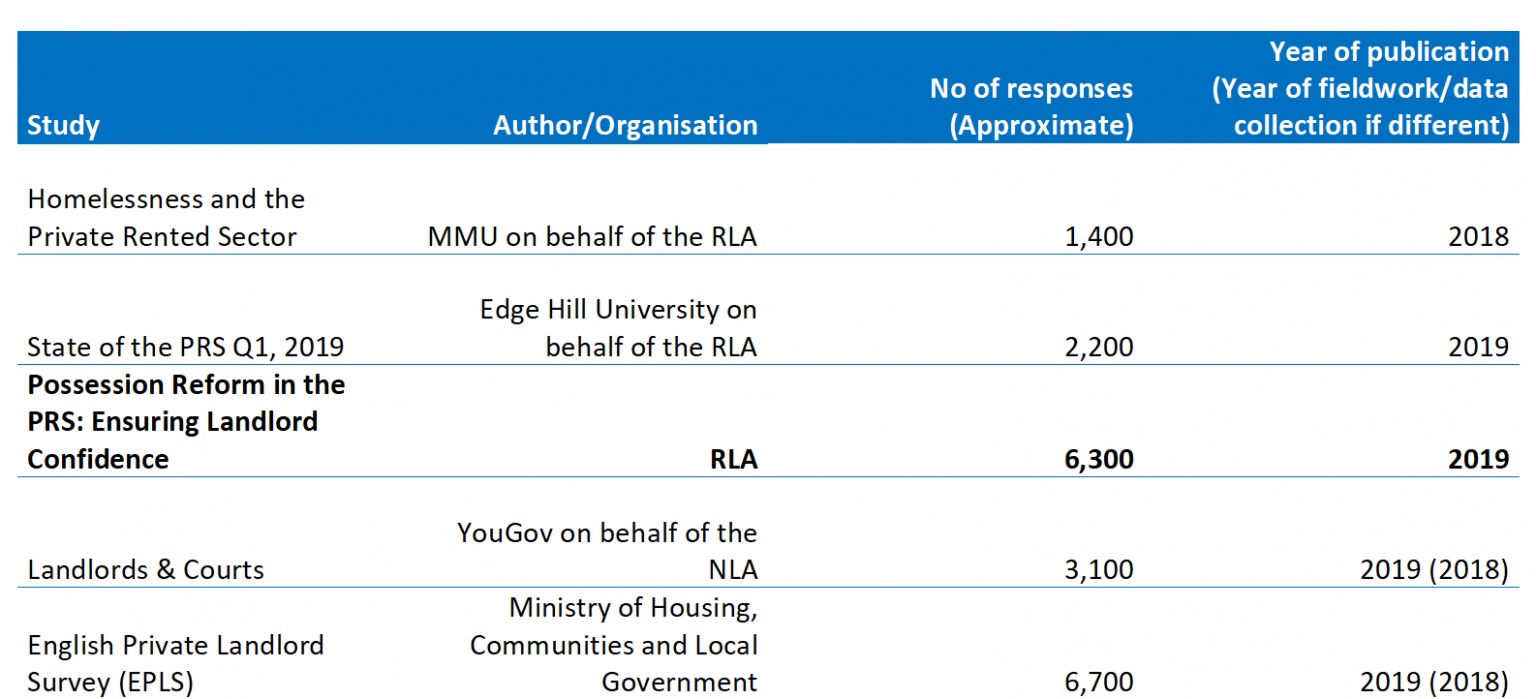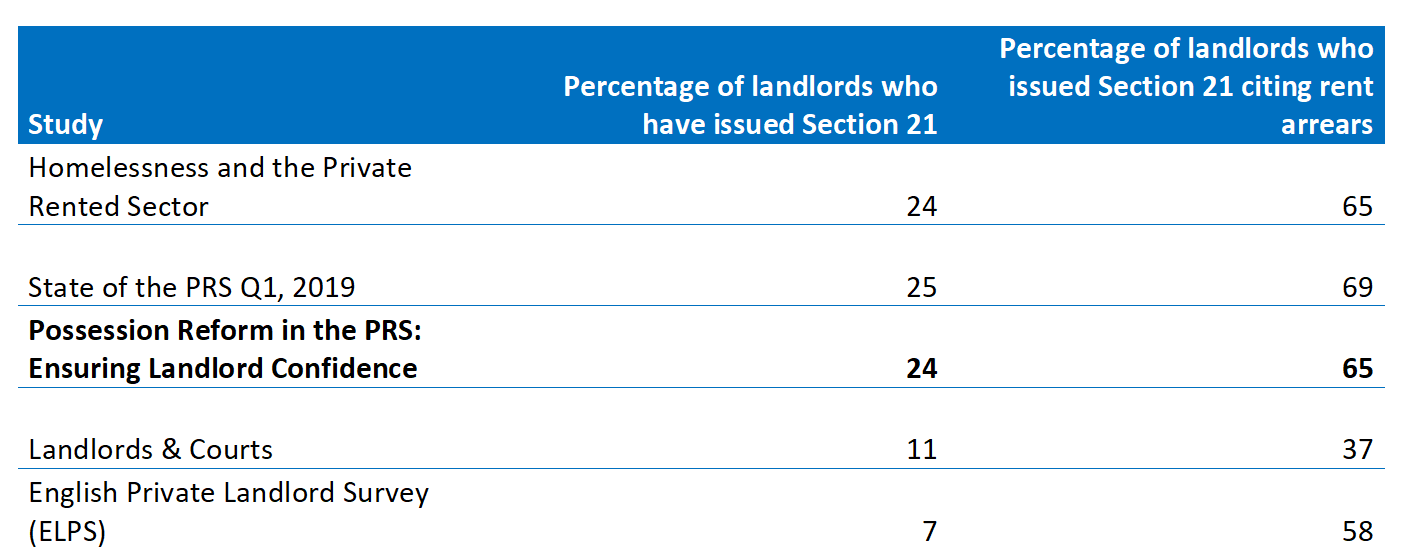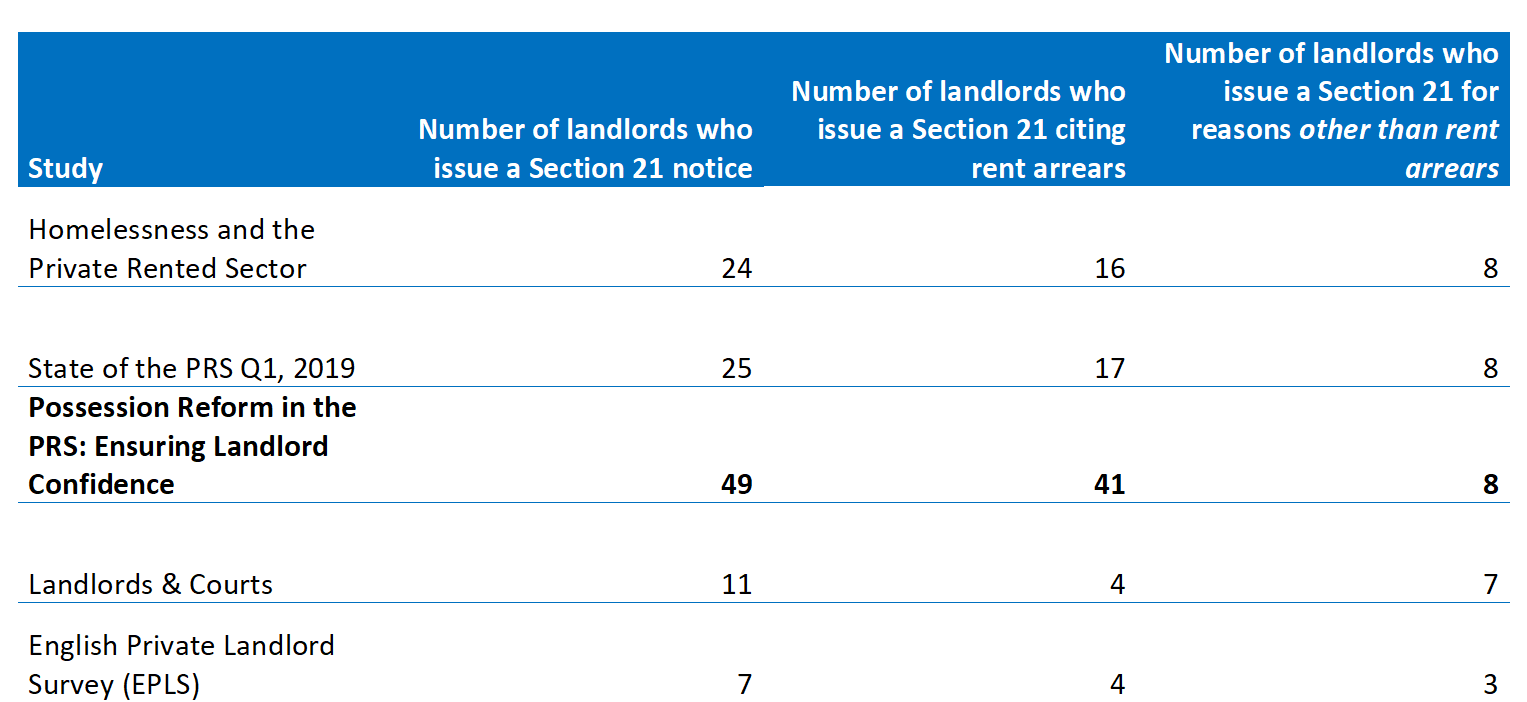

Landlords & their sparing use of Section 21: The evidence is clear & consistent
This post looks across a range of landlord surveys. The research finds the pattern of landlord use of Section 21 is remarkably consistent.
This consistency is reflected in membership surveys and Government surveys.
The studies agree landlords use Section 21 sparingly. Typically it is used in place of Section 8.
The findings emphasise the need for court reform to speed up justice in the face of proposed legislation to abolish Section 21.
Introduction
The former Residential Landlords Association (RLA), now NRLA, submitted evidence to the Equality, Local Government and Communities Committee of the Welsh Senned. This short post reviews a part of that evidence and looks at RLA – and NLA – research into the use of Section 21.
It is the consistency of the evidence which is striking. Landlords typically use Section 21 scarcely and responsibly. In the absence of evidence (rather than anecdote) to the contrary, the research produced by the RLA, the NLA and – going forward – the NRLA, provides the best available evidence of landlords’ actions, motivations and behaviours.
Background
The RLA’s aim in the evidence it presented to the Welsh Parliament was to underscore a series of research reports into the Private Rented Sector (PRS).
Specifically, to use these reports to demonstrate that repossessions via the “Section 21 route” was a rarely used tool. It has long been the RLA's contention that Section 21 was being widely used as alternative to Section 8.
Research the former RLA has undertaken has shown the problems of waiting times and delays within the court system. Inevitably this has led to landlord frustration. The result has been a preference for Section 21 over Section 8 as the mechanism to take back possession of property for reasons such as rent arrears or anti-social behaviour .
RLA evidence: Part I
By being a member of an organisation like the former RLA, the landlords who respond to organisation surveys are probably more aware of their rights than other landlords. Crucially, surveys typically show they are also more aware of their responsibilities than other landlords.
These landlords may indeed be better informed through their membership and participation in landlord-networks and communities. There is however no evidence that this makes them behave any differently in respect of taking back possession of their property.
Landlord organisations try and make their surveys as robust as possible – using the best available tools to ensure data security and data reliability. The data the former RLA collected is [predominantly, but not exclusively] from members.
To the researchers involved in delivering these studies, it is highly unlikely grown adults balancing work, family as well as their landlord businesses would be sufficiently motivated to complete multiple in-depth questionnaires. This is backed up by analysis of survey responses as well as results.
As members will confirm, the organisation takes a great deal of time to raise response rates – individuals completing the surveys multiple times is not really an issue!
RLA evidence: Part II
Of crucial importance is whether the information we collect and report on is robust and consistent.
Table 1 below outlines a number of key, recent studies on landlords and Section 21. Three of the studies have been undertaken by the former RLA and can be found on this web site. These are all predominantly (but not exclusively) surveys of former RLA members. They have a broadly similar methodology and data collection process.
The NLA also undertake research. In December 2018 it commissioned YouGov to undertake an online survey of landlords. Just over 3,000 (3,088) landlords replied to this survey. This was not a member survey but a survey of the portion of their large participant panel who happen to be landlords.
In addition, we have added to the evidence base data from the English Private Landlord Survey (EPLS). Unfortunately, this survey is only undertaken occasionally and – as its name implies – presents data only on England-based landlords. Unlike the NLA and RLA surveys, the EPLS weight their survey responses.
This is a Government-sponsored survey and an incredible amount of work goes into ensuring the sample and subsequent weighting is typical of the sector as a whole.
Table 1: Studies which report landlords' use of Section 21

Analysis
Each of these studies asked landlords whether they had issued Section 21 notices.
Each study also went on to ask those that did the reasons they had issued a Section 21. Note that many landlords will issue a Section 21 for multiple reasons, rent arrears being among them.
Table 2 below focuses on those who issued Section 21 notices because of rent arrears, which is in many studies, the most common single reason for issuing a Section 21 notice.
Table 2: Summary of research into Section 21 usage

Note that the MMU study, though an anonymised survey of RLA members, was undertaken by that academic institution. The above is an objective interpretation of their results based on the report’s contents.
Modelling the pattern of Section 21 use
These studies, though the results appear to vary, actually show a remarkably consistent pattern – one which emphasises the RLA’s argument that Section 21 is a tool which landlords use sensibly and responsibly.
The table below uses a simple funnel-system to explain how the results in Table 2 map the actual use of Section 21 among the surveyed landlords. Table 3 simply considers 100 landlords who participated in the study and uses the results in Table 2 in the following way:
- As a simple probability of firstly issuing a Section 21
- The next column then translates the proportion of landlords who issued a Section 21 for rent areas into a number
- The final column of Table 3 is then the number of landlords per 100 who issued a Section 21 notice for a reason other than rent arears
Table 3: Use of Section 21 per 100 landlords

It is the right-hand column of this table which is key. The results show a remarkably consistent pattern.
For each of the studies above, only between 3 and 8 landlords out of 100 issue a Section 21 for reasons other than rent arrears.
The EPLS utilises the widest databases of landlords of all the studies. It is this study which gives the most conservative estimate of use of Section 21 for non-rent arrears purposes. Just THREE landlords out of one-hundred in this survey issued Section 21 notices for reasons which did not include rent arrears.
The RLA study specifically into Section 21 (and therefore sure to attract those who have experience of using this method to gain possession of a property) is among those at the high end of the calculation: in this study eight out every hundred landlords in this study have used a Section 21 for reasons other than rent arrears.
Included in the final column of figures are landlords who issue Section 21 notices for a range of anti-social behaviours. These include criminal activity and breaches of contract. Each of the research reports confirm this assertion.
Once these are deducted one can see the proportion of landlords using Section 21 maliciously, selfishly or in a retaliatory fashion becomes very small indeed.
Conclusions
To summarise:
- The evidence underlines the former RLA (and NLA) stance that Section 21 is a tool used sparingly – and typically as an alternative to Section 8.
- Member-based data has been the best available on a regular basis. The more complex the method in drawing up a sample, the less frequent the study.
- Though the reported numbers differ, the pattern of results is broadly consistent across all studies, no matter the sampling method.
- Contrary to preconceptions, compared to the larger national (English) study, analysis undertaken by the RLA (and the NLA) is probably an upper estimate of the use of Section 21 for reasons other than rent arrears.
This article is written by Nick Clay, NRLA. It has benefitted from comments and observations from John Stewart, Meera Chindooroy and Aidan Crehan also from the NRLA.
Any remaining errors are those of the author.
